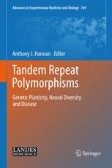Search
Search Results
-
Genomogenesis of the Plague Bacteria Yersinia pestis as a Process of Mosaic Evolution
AbstractThe guiding methodological principle of the modern molecular genetic (MG) approach to the problem of speciation of the plague bacteria Yersini...

-
Computer Simulation of the Evolution of Microbial Population: Overcoming Local Minima When Reaching a Peak on the Fitness Landscape
AbstractThe study focuses on the mechanisms of crossing the valleys of fitness by a population of haploid microorganisms, whose fitness depends on...

-
Eupolyploidy As a Mode in Plant Speciation
AbstractWhen discussing phenomena of whole genome duplication, the terms “neopolyploid,” “mesopolyploid,” and “paleopolyploid” are used in their...

-
Muscles Lost in Our Adult Primate Ancestors Still Imprint in Us: on Muscle Evolution, Development, Variations, and Pathologies
The study of evolutionary developmental pathologies (Evo-Devo-Path) is an emergent field that relies on comparative anatomy to inform our...

-
Evo-Devo Path as a Bridge between Evolution, Morphological Disparity, and Medicine with Comments on “Hopeful Monsters” in the Age of Genomics
Purpose of ReviewSince its inception in the late 1970s/early 1980s, Evolutionary Developmental Biology (Evo-Devo) has produced much insight into the...

-
Chromoanagenesis: a piece of the macroevolution scenario
Over the last decade, new types of massive and complex chromosomal rearrangements based on the chaotic shattering and restructuring of chromosomes...

-
Is cancer progression caused by gradual or simultaneous acquisitions of new chromosomes?
BackgroundFoulds defined, “Tumor progression (as a) permanent, irreversible qualitative change in one or more of its characters” (Cancer Res. 1954)....

-
Cerebral torque is human specific and unrelated to brain size
The term “cerebral torque” refers to opposing right–left asymmetries of frontal and parieto-occipital regions. These are assumed to derive from a...

-
Genetic Consequences of Interspecific Hybridization, Its Role in Speciation and Phenotypic Diversity of Plants
AbstractThe review focuses on the genetic consequences of interspecific hybridization and discusses its role in speciation and increasing the genetic...

-
The Lutzomyia longipalpis complex: a brief natural history of aggregation-sex pheromone communication
In this paper we review the natural history of pheromone communication and the current diversity of aggregation-sex pheromones in the sand fly Lutzomyi...

-
Theoretical Biology and Evolutionary Theory
During the nineteen-sixties and seventies, several biologists made decisive contributions to the development of evolutionary thought and theoretical...
-
Karyotypic evolutions of cancer species in rats during the long latent periods after injection of nitrosourea
BackgroundA century of research has established that cancers arise from tissues exposed to carcinogens only after long latencies of years to decades...

-
Theories of biological evolution from the viewpoint of the modern systemic biology
Theories of biological evolution advanced in the last 200 years are reviewed from the viewpoint of advances of modern genetics. The theory of gene...
-
Endogenous viruses: insights into viral evolution and impact on host biology
Recent studies have uncovered myriad viral sequences that are integrated or 'endogenized' in the genomes of various eukaryotes. Surprisingly, it...

-
Evolution of Simple Sequence Repeats as Mutable Sites
Because natural selection is commonly presumed to minimize mutation rates, the discovery of mutationally unstable simple sequence repeats (SSRs) in...
-
AID expression during B-cell development: searching for answers
Expression of activation-induced cytidine deaminase (AID) by germinal center (GC) B cells drives the processes of immunoglobulin (Ig) somatic...
-
The origin of polyploid genomes of bluegrasses Poa L. and Gene flow between northern pacific and sub-Antarctic Islands
The involvement of present-day diploid bluegrass species in the formation of polyploid genomes was investigated using comparison of sequences of...
-
The evolutionary significance of ancient genome duplications
Many organisms are currently polyploid, or have a polyploid ancestry and now have secondarily 'diploidized' genomes. This finding is surprising...

-
The evolution of genetic networks by non-adaptive processes
Although numerous investigators assume that the global features of genetic networks are moulded by natural selection, there has been no formal...

-

